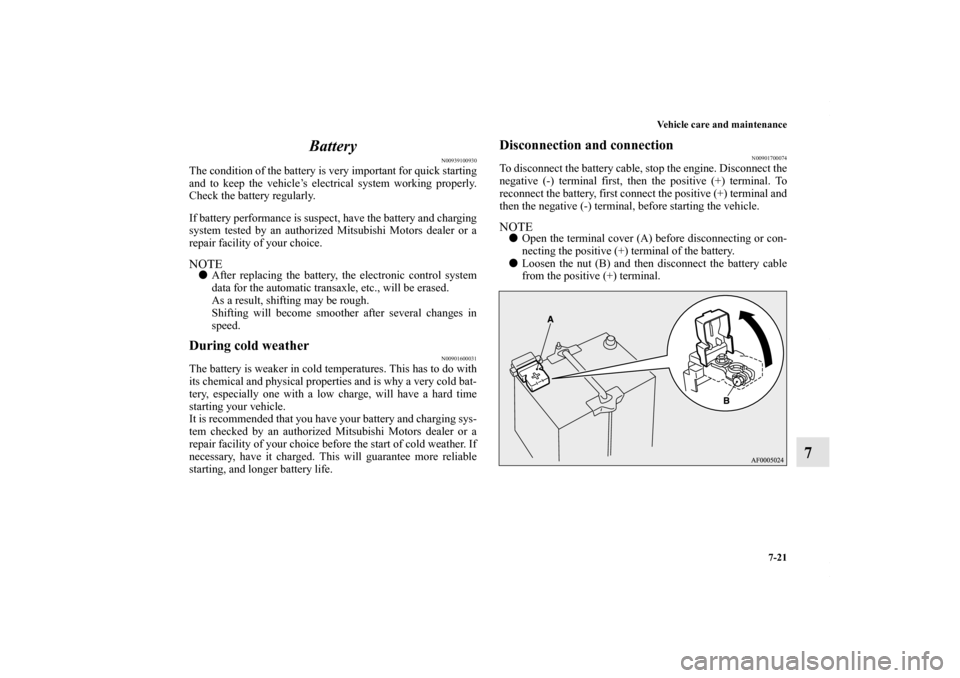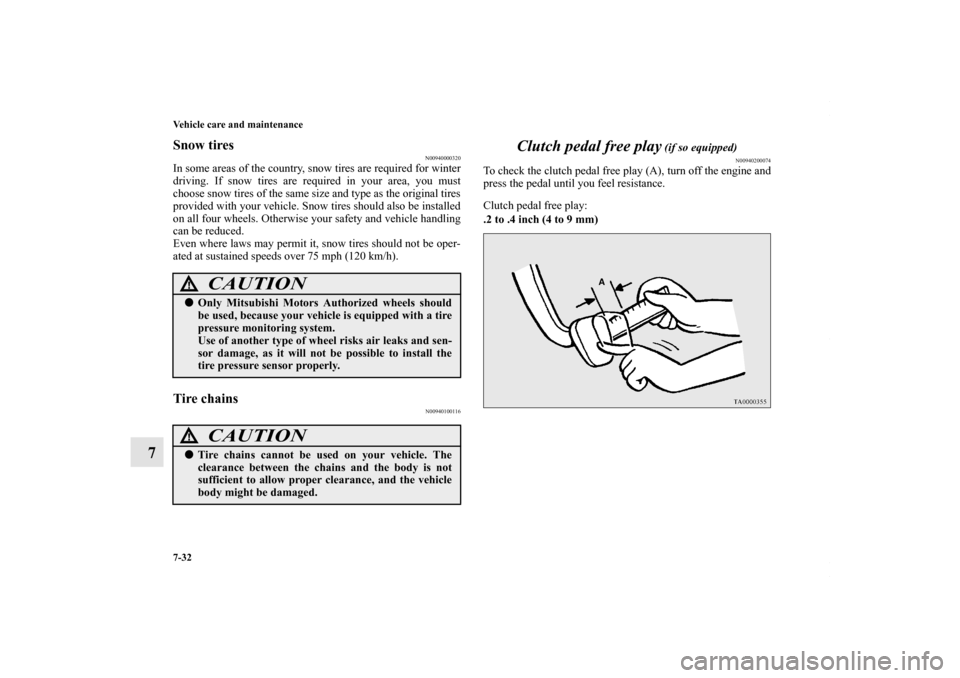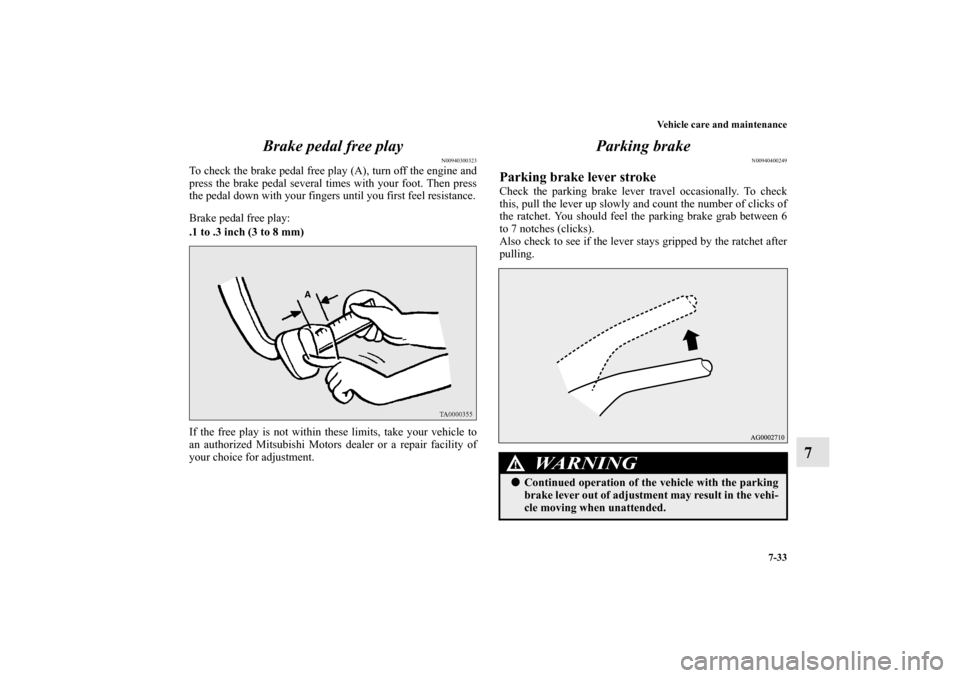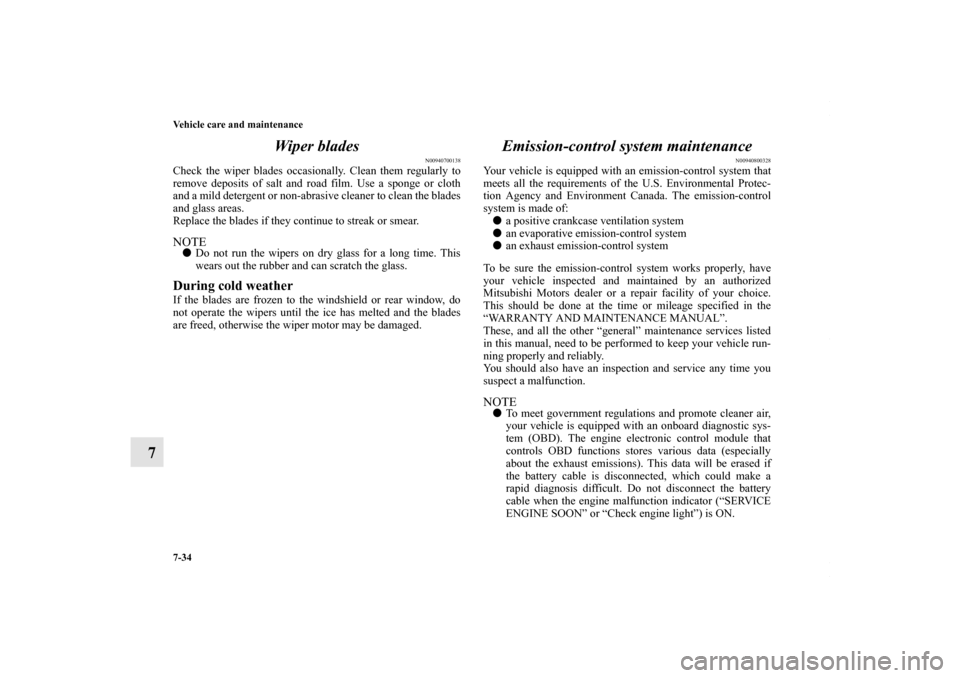Page 514 of 602
Vehicle care and maintenance7-13
7
3. Unclamp the cover. Open up the top of the cover and takeout the air cleaner filter. 4. Replacing the air cleaner filter and put the cover back on
in its original position.
NOTE� Genuine Mitsubishi Motors Parts are recommended when
replacing the air cleaner filter.
� Make sure that the connector is properly reconnected.
� After replacing the air cleaner filter, make sure that the
hinges at the bottom of cover are firmly set.
Type 1Type 2
CAUTION
!�Take care not to scratch the engine air flow sensor
when removing the air cleaner cover.
BK0150700US.book 13 ページ 2012年3月22日 木曜日 午後6時46分
Page 520 of 602
Vehicle care and maintenance7-19
7
Rear axle oil (All-wheel drive models)
N00915200269
Whenever the oil level is checked, add oil as necessary to
maintain the proper level.
Fill or change oil according to the table.Fluid type
Wa s h e r f l u i d
N00938600299
The windshield and rear window washer fluid reservoir is in
the engine compartment.
Check the washer fluid level at regular intervals and add
washer fluid to reservoir if necessary.
Open the reservoir cap and check the fluid level with the dip-
stick.
When freezing weather is anticipated, flush out the water in the
reservoir by operating the pump. Fill the reservoir with wind-
shield antifreeze (not radiator antifreeze), and operate the sys-
tem for a few seconds to flush out the residual water.
Lubricant
Mitsubishi Motors Genuine Super Hypoid
Gear Oil API classification GL-5
Viscosity range SAE 80
FULL
EMPTY
BK0150700US.book 19 ページ 2012年3月22日 木曜日 午後6時46分
Page 521 of 602

7-20 Vehicle care and maintenance
7Brake fluid/Clutch fluid
(if so equipped)
N00938700245
The brake fluid and the clutch fluid share the reservoir tank.To check the fluid levelThe fluid level must be between the “MAX” and “MIN” marks
on the reservoir.
The fluid level falls slightly with wear of the brake pads, but
this does not indicate any abnormality.
The fluid in the master cylinder should be checked when doing
other work under the engine hood. The brake system should
also be checked for leaks at the same time.
If the fluid level falls markedly in a short length of time, it indi-
cates leaks from the brake system.
If this occurs, have the vehicle checked by an authorized
Mitsubishi Motors dealer or a repair facility of your choice.
Fluid typeUse the brake fluid conforming to DOT 3 or DOT 4. The reser-
voir cap must be tightly sealed to keep dirt and water out.
MAX
MIN
CAUTION
!�
Do not let any petroleum-based fluid touch, mix
with, or get into the brake fluid. This will damage
the seals.�Be careful when handling brake fluid. It can damage
painted surfaces.�Use only the listed brake fluid. Different brands of
brake fluid have different additives, and these can
cause a chemical reaction. Do not mix brands of
brake fluid.�Keep the reservoir tank cap closed to keep the brake
fluid from evaporating.
BK0150700US.book 20 ページ 2012年3月22日 木曜日 午後6時46分
Page 522 of 602

Vehicle care and maintenance7-21
7
Battery
N00939100930
The condition of the battery is very important for quick starting
and to keep the vehicle’s electrical system working properly.
Check the battery regularly.
If battery performance is suspect, have the battery and charging
system tested by an authorized Mitsubishi Motors dealer or a
repair facility of your choice.NOTE�
After replacing the battery, the electronic control system
data for the automatic transaxle, etc., will be erased.
As a result, shifting may be rough.
Shifting will become smoother after several changes in
speed.During cold weather
N00901600031
The battery is weaker in cold temperatures. This has to do with
its chemical and physical properties and is why a very cold bat-
tery, especially one with a low charge, will have a hard time
starting your vehicle.
It is recommended that you have your battery and charging sys-
tem checked by an authorized Mitsubishi Motors dealer or a
repair facility of your choice before the start of cold weather. If
necessary, have it charged. This will guarantee more reliable
starting, and longer battery life.
Disconnection and connection
N00901700074
To disconnect the battery cable, stop the engine. Disconnect the
negative (-) terminal first, then the positive (+) terminal. To
reconnect the battery, first connect the positive (+) terminal and
then the negative (-) terminal, before starting the vehicle.NOTE�Open the terminal cover (A) before disconnecting or con-
necting the positive (+) terminal of the battery.
� Loosen the nut (B) and then disconnect the battery cable
from the positive (+) terminal.
BK0150700US.book 21 ページ 2012年3月22日 木曜日 午後6時46分
Page 523 of 602

7-22 Vehicle care and maintenance
7
NOTE�Check each battery terminal for corrosion. You can stop
more corrosion by washing with a solution of baking soda
and water. Grease the posts and clamps after cleaning or
tightening them.
� Check to see that the battery is securely installed and can-
not be moved. Also check each terminal for tightness.
� If you will not be driving your vehicle for a long period of
time, remove the battery and store it in a place where the
battery fluid will not freeze. The battery only should be
stored with a full charge.
� Before cleaning the battery, tighten all the filler port caps
to keep dirt and moisture out.
WARNING
!�Never disconnect the battery while the engine is run-
ning, or you could damage the vehicle’s electrical
parts.�Never short-circuit the battery. This could cause it
to overheat and be damaged.�Keep sparks, cigarettes, and flames away from the
battery because the battery could explode.�Electrolyte (battery acid) is made of corrosive
diluted sulfuric acid. If it spills on nearby parts, it
can crack, stain, or discolor them. And if it gets on
your skin or in your eyes, it can cause burns or
blindness. Please observe the following handling
instructions:
• If electrolyte gets on plastic parts or other nearby
parts, wipe it off with a soft cloth or chamois
soaked in a solution of water and neutral detergent
then immediately rinse the affected parts with
plenty of water.
• If electrolyte gets on your hands or clothes, rinse thoroughly with water. If electrolyte gets in your
eyes, flush them with water immediately and get
immediate medical attention.
� Open doors and windows in any closed space where
you may be charging or working with the battery.�Always wear protective clothing and goggles when
working with the battery, or have a skilled automo-
bile technician do it.�If you are quick-charging your battery, first discon-
nect the battery cables.
� In order to prevent a short-circuit, be sure to discon-
nect the negative (-) terminal first, and reconnect it
last.�Battery posts, terminals and related accessories con-
tain lead and lead compounds. Wash hands after
handling.
WARNING
!
BK0150700US.book 22 ページ 2012年3月22日 木曜日 午後6時46分
Page 533 of 602

7-32 Vehicle care and maintenance
7
Snow tires
N00940000320
In some areas of the country, snow tires are required for winter
driving. If snow tires are required in your area, you must
choose snow tires of the same size and type as the original tires
provided with your vehicle. Snow tires should also be installed
on all four wheels. Otherwise your safety and vehicle handling
can be reduced.
Even where laws may permit it, snow tires should not be oper-
ated at sustained speeds over 75 mph (120 km/h).Tire chains
N00940100116
Clutch pedal free play
(if so equipped)
N00940200074
To check the clutch pedal free play (A), turn off the engine and
press the pedal until you feel resistance.
Clutch pedal free play:
.2 to .4 inch (4 to 9 mm)
CAUTION
!�Only Mitsubishi Motors Authorized wheels should
be used, because your vehicle is equipped with a tire
pressure monitoring system.
Use of another type of wheel risks air leaks and sen-
sor damage, as it will not be possible to install the
tire pressure sensor properly.
CAUTION
!�Tire chains cannot be used on your vehicle. The
clearance between the chains and the body is not
sufficient to allow proper clearance, and the vehicle
body might be damaged.
BK0150700US.book 32 ページ 2012年3月22日 木曜日 午後6時46分
Page 534 of 602

Vehicle care and maintenance7-33
7
Brake pedal free play
N00940300323
To check the brake pedal free play (A), turn off the engine and
press the brake pedal several times with your foot. Then press
the pedal down with your fingers until you first feel resistance.
Brake pedal free play:
.1 to .3 inch (3 to 8 mm)
If the free play is not within these limits, take your vehicle to
an authorized Mitsubishi Motors dealer or a repair facility of
your choice for adjustment.
Parking brake
N00940400249
Parking brake lever strokeCheck the parking brake lever travel occasionally. To check
this, pull the lever up slowly and count the number of clicks of
the ratchet. You should feel the parking brake grab between 6
to 7 notches (clicks).
Also check to see if the lever stays gripped by the ratchet after
pulling.
WARNING
!�
Continued operation of the vehicle with the parking
brake lever out of adjustment may result in the vehi-
cle moving when unattended.
BK0150700US.book 33 ページ 2012年3月22日 木曜日 午後6時46分
Page 535 of 602

7-34 Vehicle care and maintenance
7Wiper blades
N00940700138
Check the wiper blades occasionally. Clean them regularly to
remove deposits of salt and road film. Use a sponge or cloth
and a mild detergent or non-abrasive cleaner to clean the blades
and glass areas.
Replace the blades if they continue to streak or smear.NOTE�
Do not run the wipers on dry glass for a long time. This
wears out the rubber and can scratch the glass.During cold weatherIf the blades are frozen to the windshield or rear window, do
not operate the wipers until the ice has melted and the blades
are freed, otherwise the wiper motor may be damaged.
Emission-control system maintenance
N00940800328
Your vehicle is equipped with an emission-control system that
meets all the requirements of the U.S. Environmental Protec-
tion Agency and Environment Canada. The emission-control
system is made of:
� a positive crankcase ventilation system
� an evaporative emission-control system
� an exhaust emission-control system
To be sure the emission-control system works properly, have
your vehicle inspected and maintained by an authorized
Mitsubishi Motors dealer or a repair facility of your choice.
This should be done at the time or mileage specified in the
“WARRANTY AND MAINTENANCE MANUAL”.
These, and all the other “general” maintenance services listed
in this manual, need to be performed to keep your vehicle run-
ning properly and reliably.
You should also have an inspection and service any time you
suspect a malfunction.NOTE� To meet government regulations and promote cleaner air,
your vehicle is equipped with an onboard diagnostic sys-
tem (OBD). The engine electronic control module that
controls OBD functions stores various data (especially
about the exhaust emissions). This data will be erased if
the battery cable is disconnected, which could make a
rapid diagnosis difficult. Do not disconnect the battery
cable when the engine malfunction indicator (“SERVICE
ENGINE SOON” or “Check engine light”) is ON.
BK0150700US.book 34 ページ 2012年3月22日 木曜日 午後6時46分